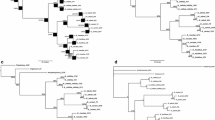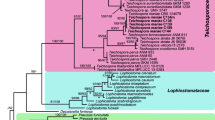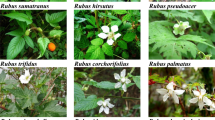Abstract
Thirty-three collections of Leotia were used to investigate inter-and infra-specific relationships in the genus. Collections were obtained from various parts of the world and represent the ascomatal color forms typical in species of the genus. The ITS rDNA and a variable region of the RNA polymerase II (RPB2) gene were sequenced and analyzed using parsimony and maximum likelihood methods. Although ITS and RPB2 tree topologies differed in regard to the position of two clades of L. lubrica and L. atrovirens, no significant conflict between ITS and RPB2 data or trees was found as determined by the partition homogeneity test. RPB2 sequences in general gave results comparable to ITS; the RPB2 sequences were more easily aligned. Phylogenetic analysis of the sequence data indicates that L. viscosa, L. lubrica and L. atrovirens are polyphyletic species. This suggests that ascomatal color in fresh specimens is not a reliable character alone for determining species in this group. Four major well-supported groups were found; these do not fully correspond to the commonly recognized species. Stipe color, in both fresh and dry condition, seems to correlate with the major recognized groups but features of the ascospores, asci and paraphyses prove too variable to be informative. The most basal group of Leotia species, identified as L. atrovirens, differ from all others by having stipes without gel tissue in their outer layers.
Similar content being viewed by others
References
Arpin N (1969) Les caroténoïdes des Discomycètes: essai chimiotaxinomique. — Bulletin Mensuel de la Société Linnéenne de Lyon 38(suppl.): 1–169.
Baral, H-O (1999) Vital versus herbarium taxonomy: morphological differences between living and dead cells of ascomycetes and their taxonomic implications. — Mycotaxon 44: 333–390
Baral H-O (1999) Ombrophila hemiamyloidea, an aquatic discomycete. — Mycologia Bavarica 3: 50–63.
Baum DA, Sytsma KJ, Hoch PC (1994) A phylogenetic analysis of Epilobium (Onagraceae) based on nuclear ribosomal DNA sequences. — Systematic Botany 19: 363–388.
Benedix EH (1955) Die Ascomycetengattung Leotia Hill. emend. Bx. und ihre Vertreter in Mitteleuropa. — Feddes Repertorium Specierum Novarum Regni Vegetabilis 58: 198–208.
Durand EJ (1908) The Geoglossaceae of North America. — Annales Mycologici 6: 387–477.
Farris JS, Kallersjo M, Kluge AG, Bult C (1994) Testing significance of incongruence. — Cladistics 10: 315–319.
Felsenstein J (1981) Evolutionary trees from DNA sequences: A maximum likelihood approach. — Journal of Molecular Evolution 17: 368–376.
Felsenstein J (1985) Confidence limits on phylogenies: an approach using the bootstrap. — Evolution 39: 783–791.
Gernandt DS, Platt JL, Stone JK, Spatafora JW, Holst-Jensen A, Hamelin RC, Kohn LM (2001) Phylogenetics of Helotiales and Rhytismatales based on partial small subunit nuclear ribosomal DNA sequences. — Mycologia 93: 915–933.
Goldman N (1993a) Simple diagnostic statistical test of models of DNA substitution. — Journal of Molecular Evolution 37: 650–661.
Goldman N (1993b) Statistical tests of models of DNA substitution. — Journal of Molecular Evolution 36: 182–198.
Grund DW, Harrison KA (1967) Nova Scotian fungi: Geoglossaceae. — Canadian Journal of Botany 45: 1625–1641.
Hansen K, Pfister DH, Hibbett DS (1999) Phylogenetic relationships among species of Phillipsia inferred from molecular and morphological data. — Mycologia 91: 299–314.
Hasegawa M, Kishino H, Yano T (1985) Dating the human-ape split by a molecular clock of mitochondrial DNA. — Journal of Molecular Evolution 22: 160–174.
Imai S (1936) Studies on the Geoglossaceae of Japan. II. The genus Leotia. — Botanical Magazine. Tokyo 50: 9–16.
Imai S (1941) Geoglossaceae Japoniae. — Journal of the Faculty of Agriculture, Hokkaido Imperial University 45: 155–264.
Jukes TH, Cantor CR (1969) Evolution of protein molecules. In Munro HN, Allison JB (eds) Mammalian protein metabolism, pp. 21–132. Academic Press New York.
Kimura M (1980) A simple method for estimating evolutionary rate of base substitutions through comparative studies of nucleotide sequences. — Journal of Molecular Evolution 16: 111–120.
Kishino H, Hasegawa M (1989) Evaluation of the maximum likelihood estimate of the evolutionary tree topologies from DNA sequence data, and the branching order in Hominoidea. — Journal of Molecular Evolution 29: 170–179.
Korf RP (1958) Japanese Discomycete Notes I–VIII. — Science Reports of the Yolohama National University, Section II. Biological and Geological Sciences 7: 7–35.
Korf RP (1973) Discomycetes and Tuberales. In Ainsworth GC, Sparrow FK, Sussmann AS (eds) The fungi-An advanced treatise, 4A, pp 249–319. Academic press New York and London.
Korf RP, Iturriaga T, Lizon P (1996) (1245) Proposal to conserve the family name Helotiaceae (Fungi). — Taxon 45: 683–684.
Korf RP, Lizon P (2000) Validation of Nannfeldt’s ordinal name Helotiales. — Mycotaxon 75: 501–502.
Korf RP, Lizon P (2001) The status of the ordinal name Leotiales. — Czech Mycology 52: 255–257.
Landvik S, Shailer NFJ, Eriksson OE (1996) SSU rDNA sequence support for a close relationship between the Elaphomycetales and the Eurotiales and Onygenales. — Mycoscience 37: 237–241.
Landvik S, Kristiansen R, Schumacher T (1998) Phylogenetic and structural studies in the Thelebolaceae (Ascomycota). — Mycoscience 39: 49–56.
Lanave C, Preparata G, Saccone C, Serio G (1984) A new method for calculating evolutionary substitution rates. — Journal of Molecular Evolution 20: 86–93.
Liu YJ, Whelen S, Hall BD (1999) Phylogenetic relationships among Ascomycetes: evidence from an RNA polymerase II subunit. — Molecular Biology and Evolution 16: 1799–1808.
Lizon P, Korf RP, Iturriaga T (1998) A preliminary discomycete flora of Macaronesia — Part 18, Leotiales. — Mycotaxon 67: 73–83.
Mains EB (1956) North American species of the Geoglossaceae. Tribe Cudonieae. — Mycologia 48: 694–710.
Moore, EJ (1965) Ontogeny of gelatinous fungi. — Mycologia 57: 114–130.
Nannfeldt JA (1942) The Geoglossaceae of Sweden (with regard also to the surrounding countries). — Arkiv för Botanik Utgivet av K. Svenska Vetenskapsakademien 30A: 1–67.
Otani Y (1982) Cup fungi collected in Nepal 1. In Otani Y (ed) Reports on the cryptogamic study in Nepal, pp. 75–91. The National Science Museum, Tokyo.
Posada D, Crandall KA (1998) MODELTEST: testing the model of DNA substitution. — Bioinformatics 14: 817–818.
Rodriguez F, Oliver JL, Marin A, Medina JR (1990) The general stochastic model of nucleotide substitution. — Journal of Theoretical Biology 142: 485–501.
Sanderson MJ (1998) Estimating rate and time in molecular phylogenies: Beyond the molecular clock? In Soltis DE, Soltis PS, Doyle JJ (eds) Molecular systematics of plants II: DNA sequencing, pp 242–264. Kluwer Academic Press.
Swofford DL (2001) PAUP*. Phylogenetic analysis using parsimony (*and other methods), version 4.0b6. Sinauer Associates Sunderland, Massachusetts, USA.
Tai FL (1944) Studies in the Geoglossaceae of Yunnan. — Lloydia 7: 147–162.
Tavare S (1986) Some probabilistic and statistical problems on the analysis of DNA sequences. — Lectures on Mathematics in the Life Sciences 17: 57–86.
Templeton AR (1983) Phylogenetic inference from restriction endonuclease cleavage site maps with particular reference to the evolution of humans and the apes. — Evolution 37: 221–244.
Thompson JD, Gibson TJ, Plewniak F, Jeanmougin F, Higgins DG (1997) The CLUSTAL X windows interface: flexible strategies for multiple sequence alignment aided by quality analysis tool. — Nucleic Acids Research 25: 4876–4882.
Velenovsky J (1934) Monographia discomycetum bohemiae, Pragae.
Verkley GJM (1994) Ultrastructure of the ascus apical apparatus in Leotia lubrica and some Geoglossaceae (Leotiales, Ascomycotina). — Persoonia 15: 405–430.
White TJ, Bruns TD, Lee S, Taylor JW (1990) Amplification and direct sequencing of fungal ribosomal RNA genes for phylogenetics. In Innis MA, Gelfand DH, Sninsky JJ, White T (eds) PCR protocols, pp 315–322. Academic Press, San Diego.
Yang Z (1994) Maximum likelihood phylogenetic estimation from DNA sequences with variable rates over sites: Approximate methods. — Journal of Molecular Evolution 39: 306–314.
Zhang N, Blackwell M. (2001) Molecular phylogeny of dogwood anthracnose fungus (Discula destructive) and the Diaporthales. — Mycologia 93: 355–365.
Author information
Authors and Affiliations
Corresponding author
Rights and permissions
About this article
Cite this article
Zhong, Z., Pfister, D.H. Phylogenetic relationships among species of Leotia (Leotiales) based on ITS and RPB2 sequences. Mycol Progress 3, 237–246 (2004). https://doi.org/10.1007/s11557-006-0094-8
Accepted:
Issue Date:
DOI: https://doi.org/10.1007/s11557-006-0094-8




